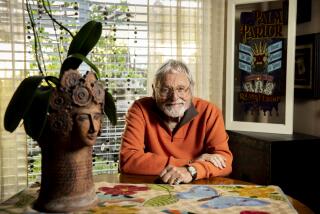‘Crumb’ does not shy away from the cartoonist’s faults — just as he wanted

- Share via
Book Review
Crumb: A Cartoonist's Life
By Dan Nadel
Scribner: 480 pages, $35
If you buy books linked on our site, The Times may earn a commission from Bookshop.org, whose fees support independent bookstores.
In his new biography of Robert Crumb, Dan Nadel writes that his subject agreed to participate in the project under one condition: “that I be honest about his faults, look closely at his compulsions, and examine the racially and sexually charged aspects of his work.” Crumb, graphically honest in his work as a surrealistic, libidinous underground comix pioneer, expected the same from his chronicler. And Nadel complied.

Which doesn’t mean “Crumb: A Cartoonist’s Life,” is a hatchet job. Far from it: Nadel, a museum curator and comics expert, expresses palpable admiration for Crumb, and sympathy for a peripatetic upbringing that could quietly be as macabre as anything he drew. He diligently tracks Crumb’s artistic progress, from collaborating with his brother, Charles, on adolescent comics in the spirit of childhood heroes such as Disney’s Carl Barks and “Little Lulu” creator John Stanley; to cranking out greeting cards for the Cleveland-based American Greetings; and to following the LSD muse into an unfettered purging of subconscious chaos. Nadel draws a vivid portrait of not just Crumb but the Bay Area-based underground comix explosion of the late ’60s and early ’70s. “Crumb” is rich in cultural context, the kind of biography that opens up an entire scene and movement.

And when it comes time to explore Crumb’s problematic depictions of women (rape fantasies became a running motif in underground comix, and in Crumb’s work) and Black people (Crumb liberally deployed Sambo stereotypes), Nadel neither excuses the artist nor issues simple condemnation.

A product of a very white, very misogynist postwar American culture (and family), Crumb often indulged in the same stereotypes he grew up with — and rendered them with grotesque vitality. Take Angelfood McSpade, “Robert’s racist fantasy of a large, muscular, and naïve Black woman seemingly made of inflated rubber.” Nadel describes her as “a stand-in for every white vision of Black women (think of the Rolling Stones’ ‘Brown Sugar’ and the marketing of Tina Turner as ‘primal’) and ultimately, for Robert, a capacious symbol of everything white American culture does to Black people.” Of Crumb’s more generalized racist depictions, Nadel writes: “Essentially it’s both racist and excoriating. Robert indicts himself, the reader, and the entire culture. He can’t help but tempt fate in order to prove a point. No happy endings or pat lessons in Crumb Land.”
Nor happy beginnings. Crumb was born in 1943 in Philadelphia to Chuck and Bea, one of five children in a family rife with mental illness. The Crumbs moved often, which only heightened Robert’s self-identification as a misfit. He and Charles, the eldest Crumb sibling, retreated into the world of comics, where they showed remarkable talent and ambition, churning out sophisticated animal narratives in the ’50s.

Nadel sets the cultural stage: “Elvis Presley was on the air, Allen Ginsberg was diagnosing the country, and the ‘sick’ comedy of Lenny Bruce, Mort Sahl, Jonathan Winters, and Stan Freberg was rising.” Perhaps most pertinent, Mad was on the magazine rack. As Nadel writes, “According to ‘Mad,’ everything was absurd, [messed] up, and on the brink of destruction, just like the Crumb household.” The magazine was a lifeline to Robert, as it was to countless other ’50s misfits. It helped foster a growing sense that everything about adult life was a lie, a theme that Nadel deftly weaves through the book.
“The instant I realized I was an outcast I became a critic, and I’ve been disgusted with American culture from the time I was a kid,” says R.
Crumb escaped to Cleveland, where he met his future wife, Dana Morgan, and in 1967 they decamped for San Francisco, where the marriage descended into open-ended craziness and his dazzling talent converged with and, in some respects, came to define the counterculture. But even here he saw himself as an outsider. “He wasn’t interested in hippies anyhow,” Nadel writes. “Of greater interest was the sudden demand for his work.” He drew the cover art for “Cheap Thrills,” the 1968 album by Big Brother and the Holding Company — Janis Joplin was a neighbor — created the seminal underground comix series “Zap Comix” and worked on other projects at a maniacal pace. He conjured the sardonic guru Mr. Natural, a tiny sex fiend called the Snoid and other sweaty, anxious creatures, human and otherwise.

He was so innovative that his work created a rippling, existential crisis among his peers. “I realized I needed to change my goals in the world,” Art Spiegelman, who only went on to win a Pulitzer Prize for “Maus” (still the only graphic novel to receive that honor), is quoted as saying in the book. “I decided I was going to become a Buddha because comics were going to be fine without me.” Crumb became famous, and while he liked the money and acclaim, he never got comfortable with it. A consummate exile, he moved to France with his second wife, artist Aline Kominsky-Crumb, and their daughter, Sophie, in 1991. Aline died in 2022.
Generously illustrated with work from throughout Crumb’s career, “Crumb” is an artist biography that astutely connects the work to the life story without forcing or simplifying anything. It works as cultural history and criticism; you won’t find a sharper analysis of the underground comix movement. Nadel honors the complexity of his subject, even, perhaps particularly, when it gets ugly.
Vognar is a freelance culture writer.
More to Read
Sign up for our Book Club newsletter
Get the latest news, events and more from the Los Angeles Times Book Club, and help us get L.A. reading and talking.
You may occasionally receive promotional content from the Los Angeles Times.










